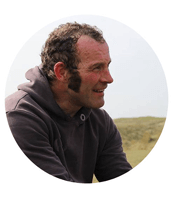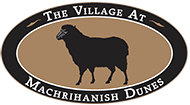Well, what a fantastic September and start to October we have had. That is two in a row now, I`m starting to think that maybe summer has swapped places with autumn! A spell of weather like we had during that time is an absolute bonanza for Scottish greenkeepers, as it allows us to tailor our program to successfully undertake aeration and overseeding programs with the minimum of disruption and the maximum of efficiency. The greens at Machrihanish Dunes have been solid tined twice in the last month, and we have managed to germinate a good percentage of the Bar Trio fescue seed we planted a few weeks ago after the initial pass with the solid tines. We have seen good root development during the last 6 weeks and this has put us in a really good position going into the Wild West Winter.

Our mission now is to protect what we have at all costs in order that we can give you all a decent surface to play on over the winter and subsequently hit the ground running in 2016.
WINTER PROJECTS
We are well into our winter work, and have already completed the task of re-positioning the bunker that used to be located in the middle of the 1st fairway. This area beneath the marker post has been turfed over and the bunker is now situated on the left side of the fairway at the corner of the dog-leg. Not only does this make the 1st tee shot more fair and less daunting for the average player, but it also provides a much more positive aiming point for the longer hitter who wishes to “cut the corner.” A new golf path has been created in front of the 15th white tee, shortening the walk and removing the requirement for players to walk all the way around the back of the tee and then to share the path with maintenance machinery. This path will be completed shortly and will in due course be covered and protected by black rubber matting.
BESPOKE SOLUTIONS
What a horrible and over-used modern catchphrase that is, but it does sum up how we should all view the maintenance programs that are being undertaken by our greenkeepers. One of our more observant members passed favourable comment a week or so ago about the outfront brushes we have fitted to our Toro Flex 21 handmowers, and he was right to heap praise on what is a simple but extremely effective tool for our particular set of greens.
 In common with all courses on the West Coast of Scotland our surfaces contain a mixture of different grasses, and while we maintain them in order to favour the perennial species of fescue and bentgrass that provide optimum playing conditions and also happen to be the least expensive and troublesome to maintain, it is almost impossible to disregard the percentage of annual meadow grass, Yorkshire fog and even perennial ryegrass which is guaranteed to be present in sportsturf which is presented in such a wet climate at what is an aggressively short height of cut.
In common with all courses on the West Coast of Scotland our surfaces contain a mixture of different grasses, and while we maintain them in order to favour the perennial species of fescue and bentgrass that provide optimum playing conditions and also happen to be the least expensive and troublesome to maintain, it is almost impossible to disregard the percentage of annual meadow grass, Yorkshire fog and even perennial ryegrass which is guaranteed to be present in sportsturf which is presented in such a wet climate at what is an aggressively short height of cut.
Even if we were to look exclusively at fescue and bent, we would see that they require slightly different management regimes in order to produce optimum health and results, which unfortunately ensures that maintaining them together effectively in a sward will result in compromising the health of either or indeed both of them. Bentgrass maintained under stress will inevitably produce lateral growth which is impossible for a mower set even as low as our summer greens height to pick up, and if this growth is allowed to spread unchecked it will result in a slow, bumpy surface. It would seem obvious for us to use our verticutters or groomers (scarifiers with very fine, closely spaced lateral blades) to regularly control and refine this lateral growth while simultaneously thinning out the spread of annual meadow grass and removing its seed heads…were it not for the extremely negative impact that this practice would have on our fescue. Fescue is an important component of any links sward, for not only does it have an ultra-fine leaf that provides optimum putting conditions, but it is far more tolerant of the battering that our course gets from wind, rain and salt than are any of the other aforementioned grasses. While it may be naturally capable of surviving the worst conditions that a west coast winter can pummel it with, its fine leaves will soon have their photosynthetic ability catastrophically reduced if its light-capturing ability is regularly halved by over-use of a verticutter.
So what to do then? We can`t have bumpy greens, so we need to refine the lateral growth of the bentgrass and remove the seedheads from the poa annua. But we can`t hack into the greens with the verticutter as often as we`d like for fear of negatively impacting on the health of the fescue. We have already agreed that to provide our members with the best playing conditions that we can at all times of the year we need to look after the health of all three species and keep compromises to their collective health to an absolute minimum. What we have done at Machrihanish Dunes is to fit these outfront brushes to our handmowers so that we can lift the lateral growth of the bentgrass and the seedheads of the poa in order that the cylinder blades can control them in a conventional manner, without slashing mercilessly into the fescue plant with a lateral blade and compromising its health. It is so simple, but over the course of a season the regular use of these brushes in favour of semi-regular use of verticutters definitely helps us to achieve our long-term goal of optimum health in all three species. They also help to relocate topdressing sand into indentations (so forming a more even putting surface), remove disease mycelium and heavy dews from the surface of the green prior to the mower`s cylinder reaching the grass blades and break up organic matter which has accumulated on the surface (allowing oxygen to circulate better and help break that organic matter down into carbohydrates that can be utilised by grass plants.
In short, regular brushing and occasional verticutting works for us. Would we be so keen on this combination though, if we were maintaining swards of pure poa annua, or a mixture of poa annua and bentgrass where perhaps a more aggressive approach might yield better results? Perhaps in this instance a regular verticutting program would be better, combined with holocoring and more regular, light applications of topdressing. This is my point about bespoke solutions- just because we have had good results with a particular product or maintenance regime does not mean it will work on the course up the road. Every successful greenkeeper has thought long and hard about what best suits his particular course and whether he conveys that message to his members in poetically long-winded prose like I do or chooses to keep it close to his chest is entirely up to him!
We look forward to seeing you out on the course in this month. If you see us out there and you have any questions about our winter program or anything else we are doing please feel free to approach us and ask!
Simon Freeman
Head Greenkeeper
Mach Dunes Golf Club


